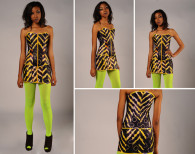 By the age of four, Matilda Ceesay knew exactly what she wanted to wear—and she wasn’t shy about telling adults how she wanted it made, either. “My mom knew to be quiet when I started drawing on the tailor’s croquis,” says Ceesay, explaining the flat sketches of the human body used by the family’s tailor back home in Kotu, The Gambia, to show designs. “What I drew may not have been legible, but I still could show him what I wanted and tell him how I wanted it made.”
By the age of four, Matilda Ceesay knew exactly what she wanted to wear—and she wasn’t shy about telling adults how she wanted it made, either. “My mom knew to be quiet when I started drawing on the tailor’s croquis,” says Ceesay, explaining the flat sketches of the human body used by the family’s tailor back home in Kotu, The Gambia, to show designs. “What I drew may not have been legible, but I still could show him what I wanted and tell him how I wanted it made.”
While Ceesay loves designing clothes, there is quite a bit more to her story. The fiber science and apparel design major at Cornell University, Ithaca, N.Y., plans to tell the story of a distinctive African aesthetic that goes beyond the traditional prints and colors associated with the continent. In the process, she plans to elevate the status of the women who live there.
Most recently, Ceesay teamed up with Frederick Ochanda—a post-doctoral associate in the Department of Fiber Science and Apparel Design, who is from Kenya—to tackle a problem common to their home countries: malaria, a disease from which members of both of their families suffer, and from which many thousands die every year.
Ochanda developed a mesh fabric with insecticide bonded into it on the molecular level. As a result, the mesh contains three times as much insecticide as the bed nets typically used in African homes. Ceesay has designed garments that provide daytime protection from disease-carrying mosquitoes in a form that lasts much longer than skin-based repellants.
“We made the prototype to inspire the industry to keep improving technologies to fight malaria—and to show that it’s not only doctors responsible for solving this problem,” Ceesay explains. “I’m a designer, and I did something about it.” Ultimately, she also wants to join forces with other African designers to create an organization modeled on the Council of Fashion Designers of America, as a means of building a thriving fashion industry.
“You can’t have a self-reliant continent if it doesn’t produce its own clothing. Imagine if there was a viable African apparel industry, so that people could buy their clothing at home rather than in Europe and the United States,” Ceesay says. “Giving resources and job skills to women so they can make their own livelihoods would be a great thing.”
 TEXTILES.ORG
TEXTILES.ORG



